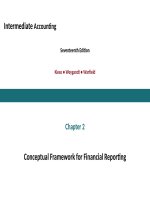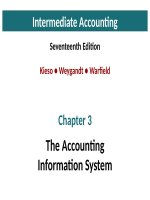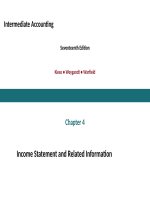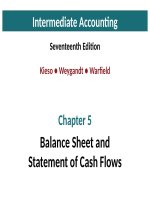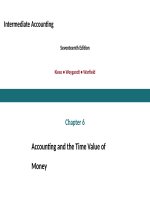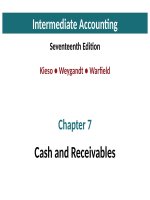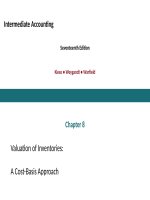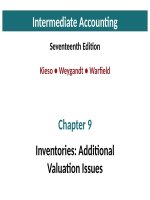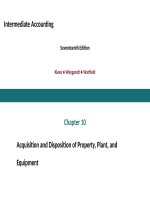Intermediate accounting 17e by kieso ch18
Bạn đang xem bản rút gọn của tài liệu. Xem và tải ngay bản đầy đủ của tài liệu tại đây (2.1 MB, 153 trang )
Intermediate Accounting
Seventeenth Edition
Kieso ● Weygandt ● Warfield
Chapter 18
Revenue Recognition
This slide deck contains animations. Please disable animations if they cause issues with your device.
Learning Objectives
After studying this chapter, you should be able to:
1.
Discuss the fundamental concepts related to revenue recognition and measurement.
2.
Explain and apply the five-step revenue recognition process.
3.
Apply the five-step process to major revenue recognition issues.
4.
Describe presentation and disclosure regarding revenue.
Copyright ©2019 John Wiley & Sons, Inc.
2
Preview of Chapter 18
Revenue Recognition
Fundamentals of Revenue Recognition
•
Background
•
New revenue recognition standard
•
Overview of five-step process: Boeing example
•
Extended example of five-step process: BEAN
Copyright ©2019 John Wiley & Sons, Inc.
3
Preview of Chapter 18
Revenue Recognition
The Five-Step Process Revisited
•
Identifying the contract with customers
•
Identifying separate performance obligations
•
Determining the transaction price
•
Allocating the transaction price
•
Satisfying performance obligations
Copyright ©2019 John Wiley & Sons, Inc.
4
Preview of Chapter 18
Revenue Recognition
Revenue Recognition Issues
•
Sales returns and allowances
•
Repurchase agreements
•
Bill-and-hold arrangements
•
Principal-agent relationships
•
Consignments
•
Warranties
•
Nonrefundable upfront fees
Copyright ©2019 John Wiley & Sons, Inc.
5
Preview of Chapter 18
Revenue Recognition
Presentation and Disclosure
•
Presentation
•
Disclosure
Copyright ©2019 John Wiley & Sons, Inc.
6
Learning Objective 1
Discuss the Fundamental Concepts Related to Revenue Recognition
and Measurement
LO 1
Copyright ©2019 John Wiley & Sons, Inc.
7
Fundamentals of Revenue Recognition
Recently, the FASB and IASB issued a converged standard on revenue recognition entitled Revenue
from Contracts with Customers.
To address the inconsistencies and weaknesses of the previous approaches, a comprehensive
revenue recognition standard now applies to a wide range of transactions and industries.
Copyright ©2019 John Wiley & Sons, Inc.
8
New Revenue Recognition Standard
Revenue from Contracts with Customers adopts an asset-liability approach. Companies:
•
Account for revenue based on the asset or liability arising from contracts with customers.
•
Are required to analyze contracts with customers
LO 1
o
Contracts indicate terms and measurement of consideration.
o
Without contracts, companies cannot know whether promises will be met.
Copyright ©2019 John Wiley & Sons, Inc.
9
New Revenue Recognition Standard
Key Concepts of Revenue Recognition
Key Objective
Recognize revenue to depict the transfer of goods or services to customers in an amount that reflects the consideration that the company receives, or
expects to receive, in exchange for these goods or services.
Five-Step Process for Revenue Recognition
1.
Identify the contract with customers.
2.
Identify the separate performance obligations in the contract.
3.
Determine the transaction price.
4.
Allocate the transaction price to the separate performance obligations.
5.
Recognize revenue when each performance obligation is satisfied.
Revenue Recognition Principle
Recognize revenue in the accounting period when the performance obligation is satisfied.
Performance Obligation is Satisfied
LO 1
Copyright ©2019 John Wiley & Sons, Inc.
10
The Five-Step Process—Boeing Example
Assume that Boeing Corporation signs a contract to sell airplanes to Delta Air Lines for $100 million.
LO 1
Copyright ©2019 John Wiley & Sons, Inc.
11
Boeing Example Step 3 and Step 4
Copyright ©2019 John Wiley & Sons, Inc.
12
Boeing Example Step 5
LO 1
Copyright ©2019 John Wiley & Sons, Inc.
13
Extended Five-Step Example
Assume coffee and wine business called BEAN. BEAN is located in the Midwest and serves gourmet coffee,
espresso, lattes, teas, and smoothies. It also sells various pastries, coffee beans, other food products, wine,
and beer.
Identifying the Contract with Customers—Step 1
Assume that Tyler Angler orders a large cup of black coffee costing $3 from BEAN. Tyler gives $3 to a BEAN
barista, who pours the coffee into a large cup and gives it to Tyler.
Question: How much revenue should BEAN recognize on this transaction?
LO 1
Copyright ©2019 John Wiley & Sons, Inc.
14
Extended Five-Step Example – Step 1
Step 1 We first must determine whether a valid contract exists between BEAN and Tyler. Here are the components of a valid
contract and how it affects BEAN and Tyler.
1. The contract has commercial substance: Tyler gives cash for the coffee.
2. The parties have approved the contract: Tyler agrees to purchase the coffee and BEAN agrees to sell it.
3. Identification of the rights of the parties is established: Tyler has the right to the coffee and BEAN has the right to
receive $3.
4. Payment terms are identified: Tyler agrees to pay $3 for the coffee.
5. It is probable that the consideration will be collected: BEAN has received $3 before it delivered the coffee.
From this information, it appears that BEAN and Tyler have a valid contract with one another.
Copyright ©2019 John Wiley & Sons, Inc.
15
Extended Five-Step Example – Step 2
Identifying Separate Performance Obligations—Step 2
The following day, Tyler orders another large cup of coffee for $3 and also purchases two bagels at a price
of $5. The barista provides these products and Tyler pays $8.
Question: How much revenue should BEAN recognize on the purchase of these two items?
LO 1
Copyright ©2019 John Wiley & Sons, Inc.
16
Extended Five-Step Example – Step 2
Identifying Separate Performance Obligations
Step 2 BEAN must determine whether the sale of the coffee and the sale of the two bagels involve one or two performance obligations. In the previous transaction between
BEAN and Tyler, this determination was straightforward because BEAN provided a single distinct product (a large cup of coffee) and therefore only one performance obligation
existed. However, an arrangement to purchase coffee and bagels may have more than one performance obligation. Multiple performance obligations exist when the following
two conditions are satisfied:
1. BEAN must provide a distinct product or service. In other words, BEAN must be able to sell the coffee and the bagels separately from one another.
2. BEAN’s products are distinct within the contract. In other words, if the performance obligation is not highly dependent on, or interrelated with, other promises in the
contract, then each performance obligation should be accounted for separately. Conversely, if each of these products is interdependent and interrelated, these products are
combined and reported as one performance obligation.
The large cup of coffee and the two bagels appear to be distinct from one another and are not highly dependent or interrelated. That is, BEAN can sell the coffee and the two
bagels separately, and Tyler benefits separately from the coffee and the bagels. BEAN should therefore record two performance obligations—one for the sale of the coffee and
one for the sale of the bagels.
LO 1
Copyright ©2019 John Wiley & Sons, Inc.
17
Extended Five-Step Example – Step 3
Determining the Transaction Price—Step 3
BEAN decides to provide an additional incentive to its customers to shop at its store. BEAN roasts its own coffee
beans and sells the beans wholesale to grocery stores, restaurants, and other commercial companies. In
addition, it sells the coffee beans at its retail location. BEAN is interested in stimulating sales of its Smoke
Jumper coffee beans on Tuesdays, a slow business day for the store. Normally, these beans sell for $10 for a 12ounce bag, but BEAN decides to cut the price by $1 when customers buy them on Tuesdays (the discounted
price is now $9 per bag). Tyler has come to the store on a Tuesday, decides to purchase a bag of Smoke Jumper
beans, and pays BEAN $9.
Copyright ©2019 John Wiley & Sons, Inc.
18
Extended Five-Step Example – Step 3
Determining the Transaction Price
Question: How much revenue should BEAN recognize on this transaction?
Step 3 The transaction price for a bag of Smoke Jumper beans sold to Tyler is $9, not $10. The transaction price is the
amount that a company expects to receive from a customer in exchange for transferring goods and services. The
transaction price in a contract is often easily determined because the customer agrees to pay a fixed amount to the
company over a short period of time. In other contracts, companies must consider adjustments such as when they
make payments or provide some other consideration to their customers (e.g., a coupon) as part of a revenue
arrangement.
LO 1
Copyright ©2019 John Wiley & Sons, Inc.
19
Extended Five-Step Example – Step 4
Allocating the Transaction Price to Separate Performance Obligations—Step 4
BEAN wants to provide even more incentive for customers to buy its coffee beans, as well as purchase a cup of
coffee. BEAN therefore offers customers a $2 discount on the purchase of a large cup of coffee when they buy a bag
of its premium Motor Moka beans (which normally sell for $12) at the same time. Tyler decides this offer is too good
to pass up and buys a bag of Motor Moka beans for $12 and a large cup of coffee for $1. As indicated earlier, a large
cup of coffee normally retails for $3 at BEAN.
LO 1
Copyright ©2019 John Wiley & Sons, Inc.
20
Extended Five-Step Example – Step 4
Allocating the Transaction Price to Separate Performance Obligations
Question: How much revenue should BEAN recognize on the purchase of these two items?
Copyright ©2019 John Wiley & Sons, Inc.
21
Extended Five-Step Example – Step 5
Recognizing Revenue When (or as) Each Performance Obligation Is Satisfied
BEAN has satisfied both performance obligations as control of the bag of Motor Moka beans
and the large cup of coffee has passed to Tyler.
Solution: BEAN should recognize revenue of $13, comprised of revenue from the sale of the
Motor Moka beans
at $10.40 and the sale of the large cup of coffee at $2.60.
LO 1
Copyright ©2019 John Wiley & Sons, Inc.
22
Learning Objective 2
Explain and Apply the Five-Step Revenue Recognition Process
LO 2
Copyright ©2019 John Wiley & Sons, Inc.
23
Identifying Contract with Customers—Step 1
Contract:
•
Agreement between two or more parties that creates enforceable rights or obligations.
•
Can be
LO 2
o
written,
o
oral, or
o
implied from customary business practice.
Copyright ©2019 John Wiley & Sons, Inc.
24
Identifying Contract—Step 1
Contracts and Recognition
Facts: On March 1, 2020, Margo Company enters into a contract to transfer a product to Soon Yoon on July 31, 2020. The contract is
structured such that Soon Yoon is required to pay the full contract price of $5,000 on August 31, 2020.The cost of the goods transferred is
$3,000. Margo delivers the product to Soon Yoon on July 31, 2020.
Question: What journal entries should Margo Company make in regards to this contract in 2020?
The journal entry to record the sale and related cost of goods sold is as follows.
July 31, 2020
Accounts Receivable
5,000
Sales Revenue
5,000
3,000
Cost of Goods Sold
Inventory
LO 2
3,000
Copyright ©2019 John Wiley & Sons, Inc.
25
